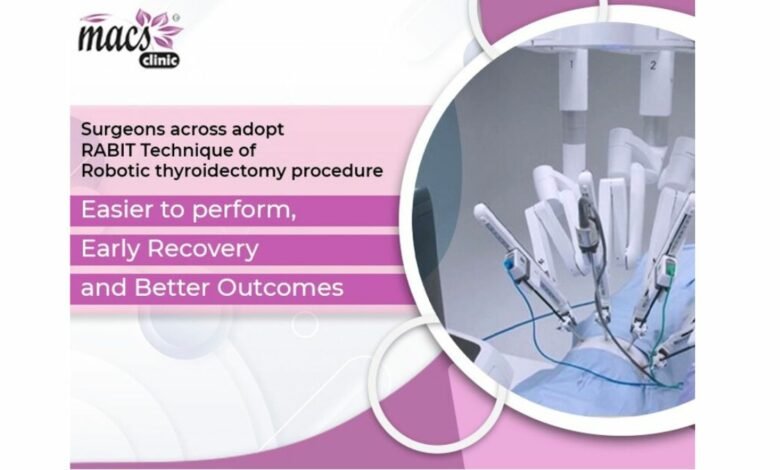Surgeons across adopt the RABIT technique of robotic thyroidectomy procedure
Dr Sandeep Nayak, MACS Clinic, Bangalore, states that RABIT procedure is easier to perform with early recovery and better outcomes in patients with thyroid issues.

Robotic thyroidectomy procedure is gaining preference over open surgery or the endoscopic approach to treat benign diseases or thyroid cancers. Scar cosmesis, less painful and speedy recovery are the main advantages of a robotic thyroidectomy.
On the other hand, the surgeons who perform robotic thyroidectomy also feel that conventional open surgery increases the risk of complications such as recurrent laryngeal nerve injury, hypoparathyroidism, bleeding, and oncological outcomes of cancer. This they attribute to the better vision quality, magnification and precision of robotic technology.
The Robotic thyroidectomy procedure emerged and is preferred mainly in Korea, Thailand and other South East Asian countries. Over the years, many robotic variations have evolved using retro auricular ( using a 7 to 10 cm wound behind the ear), transoral routes for thyroidectomy (through the mouth), robotic trans axillary(10-12 cm wound in the armpit) and Robotic Assisted Breast Axillo Insufflate Thyroidectomy – RABIT technique, and its modifications.
In India, few select surgeons perform the Robotic thyroidectomy procedure including Dr Sandeep Nayak who invented the Robotic Assisted Breast Axillo Insufflate Thyroidectomy – RABIT technique.
Relating to the development of the RABIT technique, Dr Sandeep Nayak states that he visualized a technique that would solely rely on the Robotic system and do away with the need for additional special equipment that would increase the cost of the thyroidectomy.

Also, he states, he wished to do away with the large visible scar or reduce its size as much as possible because the other robotic procedures left behind a 7-10 cm long visible scar either behind the ear or in the armpit which the patient did not prefer. All robotic thyroidectomy procedures are called remote access thyroidectomies as they place the wounds away from the neck. The RABIT procedure requires very small incisions in both armpits very close to the areola and leaves barely visible scars.
He reiterates that the quality of surgery is far superior as the Robotic techniques delivers a 20x magnified view of the surgical area enabling proximity to the organ. Similarly, it enables easy identification and safety of the nerves, parathyroid gland and other nearby organs.
With RABIT technique, it is possible to perform extensive thyroidectomy along with central compartment lymph node dissection, which includes lymph nodes around the thyroid gland and all the lymph nodes of the neck for better outcomes when needed. The entire surgery can be performed from the same small wounds.
Dr Sandeep Nayak states, ‘The RABIT technique is a minimally invasive and a safe procedure to treat thyroid cancer and benign thyroid cases, in terms of surgical as well as cosmetic outcomes. I have trained 7 centres pan India in the RABIT technique.’
He further adds, “I am elated to see that many surgeons prefer RABIT procedure or its modification like robotic BABA, over retro auricular, transoral thyroidectomyas the learning curve is shorter and easier to follow.
On a similar note, Dr ThalavaiSundarram of V S Hospital, Chennai has been trained in both trans axillary and RABIT techniques; he focuses on Robotic Thyroidectomy for the past one and a half years. He states, “RABIT mimics a classical midline open surgery in which most of the surgeons are trained. It is easily reproducible and the learning curve is shorter. “

He also states that RABIT is less invasive as compared to retroauricular, Transaxillary and Transoral approaches. Also, prior exposure to Endoscopic Thyroidectomy is not required in order to learn the RABIT technique. Further, the RABIT technique does not require additional equipment such as the Chungs retractor in case of Transaxillary approach, which increases the surgery cost.
Dr Surender Kumar Dabas, Director & Chief – Robotic Surgery Surgical Oncology, BLK Hospital, India, has trained in different approaches of robotic thyroidectomy states, ‘ I prefer the robotic bilateral axillo-breast approach -rBABAwhich is a modification of RABIT technique’.
Having trained in Korea, Dr Dabas has been regularly performing robotic thyroidectomies till now and states that robotic thyroidectomy procedures offer immense functional benefits, which include saving the voice nerve, less risk of hypocalcemia and early discharge of the patient (next-day discharge).
He opines that RABIT approach& its modification cover all the facets of thyroidectomy, including neck dissection while the other procedures are simply cosmetic in their approach.
Robotic thyroidectomy started as a procedure to avoid a scar in front of the neck, however, it appears to have several other advantages in the eyes and hands of expert surgeons. The RABIT procedure for thyroidectomy has become popular for its simplicity, safety and reproducibility.







